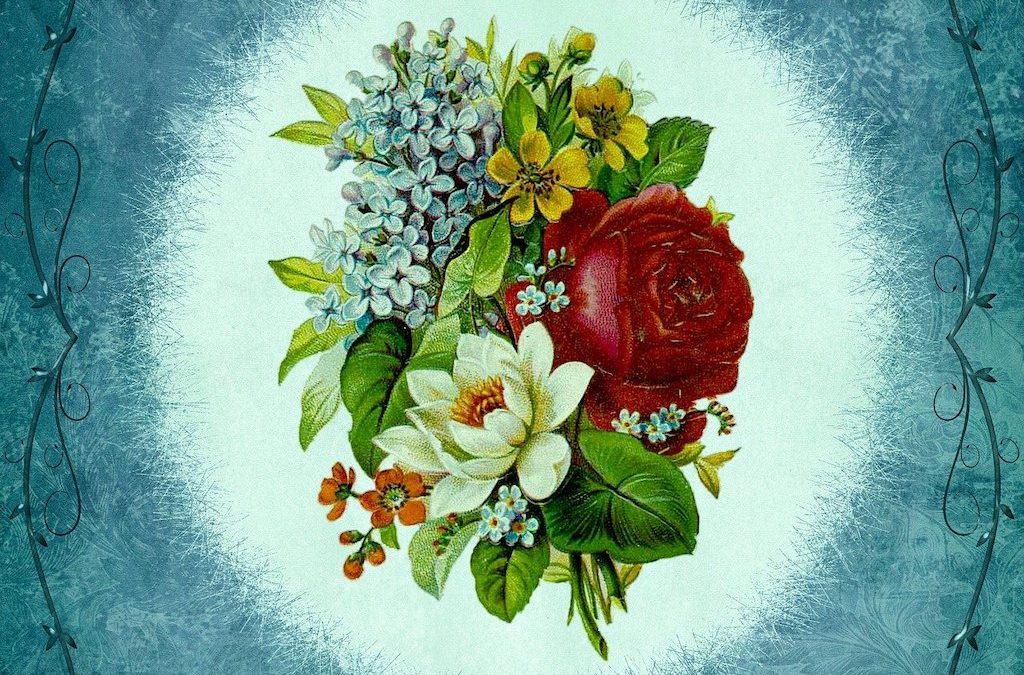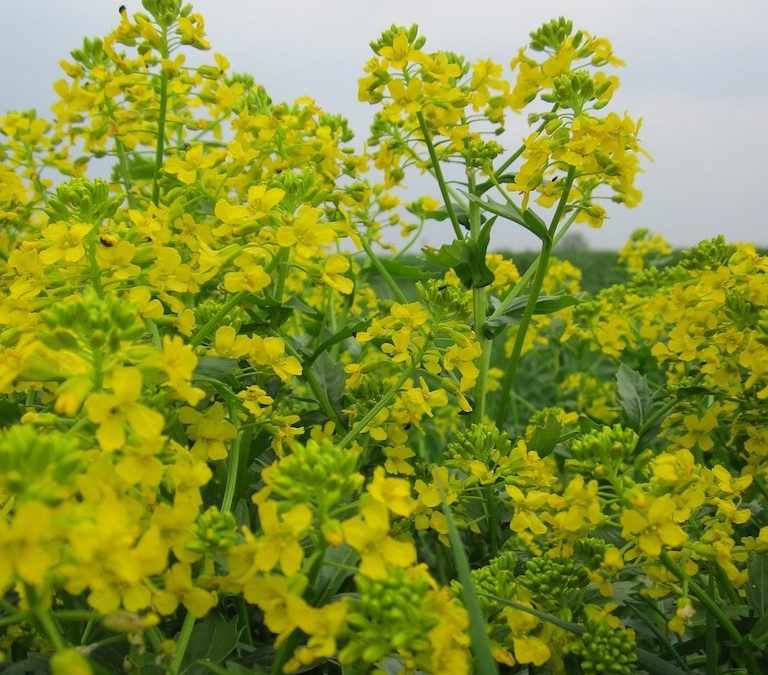
Victorian Flower Language
The Victorian flower language, also known as ‘floriography’, was a secret floral code by means of which lovers could exchange messages without the embarrassment of having to indiscreetly ask or tell someone the nature of one’s true heart’s desire. For this purpose, Victorians carried little floral bouquets called ‘tussie-mussies’. But, the meaning of each flower was not universal, and thus, could be confusing at times. Floral dictionaries were published to facilitate this silent form of communication. The craze spread far beyond Victorian England and spread throughout Continental Europe and the US.
Reprinted from:
Collier’s Cyclopedia of Commercial and Social Information and Treasury of Useful and Entertaining Knowledge,
compiled by Nugent Robinson. P.F. Collier, 1882
|
Abatina |
Fickleness |
|
Acacia |
Friendship |
|
Acacia, Rose or White |
Elegance |
|
Acacia, Yellow |
Secret love |
|
Acanthus |
The fine arts, Artifice |
|
Acalia |
Temperance |
|
Achillea Millefolia |
War |
|
Aconite (Wolfsbane) |
Misanthropy |
|
Aconite, Crowfoot |
Luster |
|
Adonis, Flos |
Painful recollections |
|
African Marigold |
Vulgar minds |
|
Agnus Castus |
Coldness, Indifference |
|
Agrimony |
Thankfulness, Gratitude |
|
Almond (Common) |
Stupidity, Indiscretion |
|
Almond (Flowering) |
Hope |
|
Almond, Laurel |
Perfidy |
|
Allspice |
Compassion |
|
Aloe |
Grief, Religious superstition |
|
Althaea Frutex (Syrian Mallow) |
Persuasion |
|
Alyssum (Sweet) |
Worth beyond beauty, |
|
Amaranth (Globe) |
Immortality, Unfading love, |
|
Amaranth (Cockscomb) |
Foppery, Affectation, |
|
Amaryllis |
Pride, Timidity, Splendid beauty |
|
Ambrosia |
Love returned |
|
Cowslip |
Divine beauty |
|
Starwort |
Welcome to a stranger, Cheerfulness in old age |
|
Anemone (Garden) |
Forsaken |
|
Angelica |
Inspiration |
|
Apple |
Temptation |
|
Apple (Blossom) |
Preference, Fame speaks him great and good |
|
Apple, Thorn |
Deceitful charms |
|
Apocynum (Dog’s Vane) |
Deceit |
|
Arbor Vitae |
Unchanging friendship, Live for me |
|
Arum (Wake Robin) |
Ardor |
|
Ash-leaved Trumpet Flower |
Separation |
|
Ash Tree |
Grandeur |
|
Aspen Tree |
Lamentation |
|
Aster (China) |
Variety, Afterthought |
|
Asphodel |
My regrets follow you to the grave |
|
Auricula |
Painting |
|
Auricula, Scarlet |
Avarice |
|
Austurtium |
Splendor |
|
Azalea |
Temperance |
|
Bachelor’s Buttons |
Celibacy |
|
Balm |
Sympathy |
|
Balm, Gentle |
Pleasantry |
|
Balm of Gilead |
Cure Relief |
|
Balsam, Red |
Touch me not, Impatient resolves |
|
Balsam, Yellow |
Impatience |
|
Barberry |
Sourness of temper |
|
Barberry Tree |
Sharpness |
|
Basil |
Hatred |
|
Bay Leaf |
I change but in death |
|
Bay (Rose) Rhododendron |
Danger Beware |
|
Bay Tree |
Glory |
|
Bay Wreath |
Reward of merit |
|
Bearded Crepis |
Protection |
|
Beech Tree |
Prosperity |
|
Bee Orchis |
Industry |
|
Bee Ophrys |
Error |
|
Belladonna |
Silence |
|
Bell Flower, Pyramidal |
Constancy |
|
Bell Flower (small white) |
Gratitude |
|
Belvedere |
I declare against you |
|
Betony |
Surprise |
|
Bilberry |
Treachery |
|
Bindweed, Great |
Insinuation |
|
Bindweed, Small |
Humility |
|
Birch |
Meekness |
|
Birdsfoot, Trefoil |
Revenge |
|
Bittersweet; Nightshade |
Truth |
|
Black Poplar |
Courage |
|
Blackthorn |
Difficulty |
|
Bladder Nut Tree |
Frivolity, Amusement |
|
Bluebottle (Century) |
Delicacy |
|
Bluebell |
Constancy |
|
Blue-flowered Greek Valerian |
Rupture |
|
Bonus Henricus |
Goodness |
|
Borage |
Bluntness |
|
Box Tree |
Stoicism |
|
Bramble |
Lowliness, Envy, Remorse |
|
Branch of Currants |
You please all |
|
Branch of Thorns |
Severity, Rigor |
|
Bridal Rose |
Happy love |
|
Broom |
Humility |
|
Buckbean |
Calm repose |
|
Bud of White Rose |
Heart ignorant of love |
|
Bugloss |
Falsehood |
|
Bulrush |
Indiscretion, Docility |
|
Bundle of Reeds, with their Panicles |
Music |
|
Burdock |
Importunity, Touch me not |
|
Buttercup (Kingcup) |
Ingratitude, Childishness |
|
Butterfly Orchis |
Gaiety |
|
Butterfly Weed |
Let me go |
|
Cabbage |
Profit |
|
Cacalia |
Adulation |
|
Cactus |
Warmth |
|
Calla Aethiopica |
Magnificent beauty |
|
Calycanthus |
Benevolence |
|
Camellia Japonica, Red |
Unpretending excellence |
|
Camellia Japonica, White |
Perfected loveliness |
|
Camomile |
Energy in adversity |
|
Canary Grass |
Perseverance |
|
Candytuft |
Indifference |
|
Canterbury Bell |
Acknowledgment |
|
Cape Jasmine |
I’m too happy |
|
Cardamine |
Paternal error |
|
Carnation, Deep Red |
Alas! for my poor heart |
|
Carnation, Striped |
Refusal |
|
Carnation, Yellow |
Disdain |
|
Cardinal Flower |
Distinction |
|
Catchfly |
Snare |
|
Catchfly, Red |
Youthful love |
|
Catchfly, White |
Betrayed |
|
Cedar |
Strength |
|
Cedar of Lebanon |
Incorruptible |
|
Cedar Leaf |
I live for thee |
|
Celandine (Lesser) |
Joys to come |
|
Century |
Delicacy |
|
Cereus (Creeping) |
Modest genius |
|
Champignon |
Suspicion |
|
Chequered Fritillary |
Persecution |
|
Cherry Tree |
Good education |
|
Cherry Tree, White |
Deception |
|
Chestnut Tree |
Do me justice, Luxury |
|
Chickweed |
Rendezvous |
|
Chicory |
Frugality |
|
China Aster |
Variety |
|
China Aster, Double |
I partake your sentiments |
|
China Aster, Single |
I will think of it |
|
China or Indian Pink |
Aversion |
|
China Rose |
Beauty always new |
|
Chinese Chrysanthemum |
Cheerfulness under adversity |
|
Christmas Rose |
Relieve my anxiety |
|
Chrysanthemum, Red |
I love |
|
Chrysanthemum, White |
Truth |
|
Chrysanthemum, Yellow |
Slighted love |
|
Cinquefoil |
Maternal affection |
|
Circaea |
Spell |
|
Cistus, or Rock Rose |
Popular favor |
|
Cistus, Gum |
I shall die tomorrow |
|
Citron |
Ill-natured beauty |
|
Clematis |
Mental beauty |
|
Clematis, Evergreen |
Poverty |
|
Clotbur |
Rudeness Pertinacity |
|
Cloves |
Dignity |
|
Clover, Four-leaved |
Be mine |
|
Clover, Red |
Industry |
|
Clover, White |
Think of me |
|
Cobaea |
Gossip |
|
Cockscomb Amaranth |
Foppery, Affectation, Singularity |
|
Colchicum, or Meadow Saffron |
My best days are past |
|
Coltsfoot |
Justice shall be done |
|
Columbine |
Folly |
|
Columbine, Purple |
Resolved to win |
|
Columbine, Red |
Anxious and trembling |
|
Convolvulus |
Bonds |
|
Convolvulus, Blue (Minor) |
Repose, Night |
|
Convolvulus, Major |
Extinguished hopes |
|
Convolvulus, Pink |
Worth sustained by judicious and tender affection |
|
Corchorus |
Impatient of absence |
|
Coreopsis |
Always cheerful |
|
Coreopsis Arkansa |
Love at first sight |
|
Coriander |
Hidden worth |
|
Corn |
Riches |
|
Corn, Broken |
Quarrel |
|
Corn Straw |
Agreement |
|
Corn Bottle |
Delicacy |
|
Corn Cockle |
Gentility |
|
Cornel Tree |
Duration |
|
Coronella |
Success crown your wishes |
|
Cowslip |
Pensiveness Winning grace |
|
Cowslip, American |
Divine beauty You are my divinity |
|
Cranberry |
Cure for heartache |
|
Creeping Cereus |
Horror |
|
Cress |
Stability, Power |
|
Crocus |
Abuse not |
|
Crocus, Spring |
Youthful, gladness |
|
Crocus, Saffron |
Mirth |
|
Crown Imperial |
Majesty, Power |
|
Crowsbill |
Envy |
|
Crowfoot |
Ingratitude |
|
Crowfoot (Aconite-leaved) |
Luster |
|
Cocoa Plant |
Ardor |
|
Cudweed, American |
Unceasing remembrance |
|
Currant |
Thy frown will kill me |
|
Cuscuta |
Meanness |
|
Cyclamen |
Diffidence |
|
Cypress |
Death, Mourning |
|
Daffodil |
Regard |
|
Dahlia |
Instability |
|
Daisy |
Innocence |
|
Daisy, Garden |
I share your sentiments |
|
Daisy, Michaelmas |
Farewell |
|
Daisy, Party-colored |
Beauty |
|
Daisy, Wild |
I will think of it |
|
Damask Rose |
Brilliant complexion |
|
Dandelion |
Rustic oracle |
|
Daphne, Odora |
Painting the lily |
|
Darnel (Ray grass) |
Vice |
|
Dead Leaves |
Sadness |
|
Dew Plant |
A serenade |
|
Dittany of Crete |
Birth |
|
Dittany of Crete, White |
Passion |
|
Dock |
Patience |
|
Dodder of Thyme |
Baseness |
|
Dogsbane |
Deceit, Falsehood |
|
Dogwood |
Durability |
|
Dragon Plant |
Snare |
|
Dried Flax |
Utility |
|
Ebony Tree |
Blackness |
|
Eglantine (Sweetbrier) |
Poetry, I wound to heal |
|
Elder |
Zealousness |
|
Elm |
Dignity |
|
Enchanter’s Nightshade |
Witchcraft, Sorcery |
|
Endive |
Frugality |
|
Eupatorium |
Delay |
|
Everflowering Candytuft |
Indifference |
|
Evergreen Clematis |
Poverty |
|
Evergreen Thorn |
Solace in adversity |
|
Everlasting |
Never-ceasing remembrance |
|
Everlasting Pea |
Lasting pleasure |
|
Fennel |
Worthy of all praise, Strength |
|
Fern |
Fascination |
|
Ficoides, Ice Plant |
Your looks freeze me |
|
Fig |
Argument |
|
Fig Marigold |
Idleness |
|
Fig Tree |
Prolific |
|
Filbert |
Reconciliation |
|
Fir |
Time |
|
Fir Tree |
Elevation |
|
Flax |
Domestic industry, Fate, I feel your kindness |
|
Flax-leaved Goldy-locks |
Tardyness |
|
Fleur-de-Lis |
Flame, I burn |
|
Fleur-de-Luce |
Fire |
|
Flowering Fern |
Reverie |
|
Flowering Reed |
Confidence in Heaven |
|
Flower-of-an-Hour |
Delicate beauty |
|
Fly Orchis |
Error |
|
Flytrap |
Deceit |
|
Fool’s Parsley |
Silliness |
|
Forget Me Not |
True love, Forget me not |
|
Foxglove |
Insincerity |
|
Foxtail Grass |
Sporting |
|
French Honeysuckle |
Rustic beauty |
|
French Marigold |
Jealousy |
|
French Willow |
Bravery and humanity |
|
Frog Ophrys |
Disgust |
|
Fuller’s Teasel |
Misanthropy |
|
Fumitory |
Spleen |
|
Fuschia, Scarlet |
Taste |
|
Garden Anemone |
Forsaken |
|
Garden Chervil |
Sincerity |
|
Garden Daisy |
I partake your sentiments |
|
Garden Marigold |
Uneasiness |
|
Garden Ranunculus |
You are rich in attractions |
|
Garden Sage |
Esteem |
|
Garland of Roses |
Reward of virtue |
|
Germander Speedwell |
Facility |
|
Geranium, Dark |
Melancholy |
|
Geranium, Ivy |
Bridal favor |
|
Geranium, Lemon |
Unexpected meeting |
|
Geranium, Nutmeg |
Expected meeting |
|
Geranium, Oak-leaved |
True friendship |
|
Geranium, Penciled |
Ingenuity |
|
Geranium, Rose-scented |
Preference |
|
Geranium, Scarlet |
Comforting stupidity |
|
Geranium, Silver-leaved |
Recall |
|
Geranium, wild |
Steadfast piety |
|
Gilliflower |
Bonds of affection |
|
Glory Flower |
Glorious beauty |
|
Goat’s Rue |
Reason |
|
Golden Rod |
Precaution |
|
Gooseberry |
Anticipation |
|
Gourd |
Extent, Bulk |
|
Grape, Wild |
Charity |
|
Grass |
Submission, Utility |
|
Guelder Rose |
Winter, Age |
|
Hand Flower Tree |
Warning |
|
Harebell |
Submission, Grief |
|
Hawkweed |
Quicksightedness |
|
Hawthorn |
Hope |
|
Hazel |
Reconciliation |
|
Heath |
Solitude |
|
Helenium |
Tears |
|
Heliotrope |
Devotion, Faithfulness |
|
Hellebore |
Scandal, Calumny |
|
Helmet Flower (Monkshood) |
Knight-errantry |
|
Hemlock |
You will be my death |
|
Hemp |
Fate |
|
Henbane |
Imperfection |
|
Hepatica |
Confidence |
|
Hibiscus |
Delicate beauty |
|
Holly |
Foresight |
|
Holly Herb |
Enchantment |
|
Hollyhock |
Ambition, Fecundity |
|
Honesty |
Honesty, Fascination |
|
Honey Flower |
Love, sweet and secret |
|
Honeysuckle |
Generous and devoted affection |
|
Honeysuckle (Coral) |
The color of my fate |
|
Honeysuckle (French) |
Rustic beauty |
|
Hop |
Injustice |
|
Hornbean |
Ornament |
|
Horse Chestnut |
Luxury |
|
Hortensia |
You are cold |
|
Houseleek |
Vivacity, Domestic industry |
|
Houstonia |
Content |
|
Hoya |
Sculpture |
|
Humble Plant |
Despondency |
|
Hundred-leaved Rose |
Dignity of mind |
|
Hyacinth |
Sport, Game, Play |
|
Hyacinth, White |
Unobtrusive loveliness |
|
Hydrangea |
A boaster, Heartlessness |
|
Hyssop |
Cleanliness |
|
Iceland Moss |
Health |
|
Ice Plant |
Your looks freeze me |
|
Imperial Montague |
Power |
|
Indian Cress |
Warlike trophy |
|
Indian Jasmine (Ipomoea) |
Attachment |
|
Indian Pink (Double) |
Always lovely |
|
Indian Plum |
Privation |
|
Iris |
Message |
|
Iris German |
Flame |
|
Ivy |
Fidelity, Marriage |
|
Ivy, Sprig of, with tendrils |
Assiduous to please |
|
Jacob’s Ladder |
Come down |
|
Japan Rose |
Beauty is your only attraction |
|
Jasmine |
Amiability |
|
Jasmine, Cape |
Transport of joy |
|
Jasmine, Carolina |
Separation |
|
Jasmine, Indian |
I attach myself to you |
|
Jasmine, Spanish |
Sensuality |
|
Jasmine, Yellow |
Grace and elegance |
|
Jonquil |
I desire a return of affection |
|
Judas Tree |
Unbelief, Betrayal |
|
Juniper |
Succor, Protection |
|
Justicia |
The perfection of female loveliness |
|
Kennedia |
Mental beauty |
|
King-cups |
Desire of riches |
|
Laburnum |
Forsaken, Pensive beauty |
|
Lady’s Slipper |
Capricious beauty, Win me and wear me |
|
Lagerstraemia, Indian |
Eloquence |
|
Lantana |
Rigor |
|
Larch |
Audacity, Boldness |
|
Larkspur |
Lightness, Levity |
|
Larkspur, Pink |
Fickleness |
|
Larkspur, Purple |
Haughtiness |
|
Laurel |
Glory |
|
Laurel Common, in flower |
Perfidy |
|
Laurel, Ground |
Perseverance |
|
Laurel, Mountain |
Ambition |
|
Laurel-leaved Magnolia |
Dignity |
|
Laurestina |
A token, I die if neglected |
|
Lavender |
Distrust |
|
Leaves (dead) |
Melancholy |
|
Lemon |
Zest |
|
Lemon Blossoms |
Fidelity in love |
|
Lettuce |
Cold-heartedness |
|
Lichen |
Dejection, Solitude |
|
Lilac, Field |
Humility |
|
Lilac, Purple |
First emotions of love |
|
Lilac, White |
Youthful innocence |
|
Lily, Day |
Coquetry |
|
Lily, Imperial |
Majesty |
|
Lily, White |
Youthful innocence |
|
Lily, Yellow |
Falsehood, Gaiety |
|
Lily of the Valley |
Return of happiness |
|
Linden or Lime Trees |
Conjugal love |
|
Lint |
I feel my obligation |
|
Live Oak |
Liberty |
|
Liverwort |
Confidence |
|
Licorice, Wild |
I declare against you |
|
Lobelia |
Malevolence |
|
Locust Tree |
Elegance |
|
Locust Tree (green) |
Affection beyond the grave |
|
London Pride |
Frivolity |
|
Lote Tree |
Concord |
|
Lotus |
Eloquence |
|
Lotus Flower |
Estranged love |
|
Lotus Leaf |
Recantation |
|
Love in a Mist |
Perplexity |
|
Love lies Bleeding |
Hopeless, not heartless |
|
Lucern |
Life |
|
Lupine |
Voraciousness, Imagination |
|
Madder |
Calumny |
|
Magnolia |
Love of nature |
|
Magnolia, Swamp |
Perseverance |
|
Mallow |
Mildness |
|
Mallow, Marsh |
Beneficence |
|
Mallow, Syrian |
Consumed by love |
|
Mallow, Venetian |
Delicate beauty |
|
Manchineal Tree |
Falsehood |
|
Mandrake |
Horror |
|
Maple |
Reserve |
|
Marigold |
Grief |
|
Marigold, African |
Vulgar minds |
|
Marigold, French |
Jealousy |
|
Marigold, Prophetic |
Prediction |
|
Marigold and Cypress |
Despair |
|
Marjoram |
Blushes |
|
Marvel of Peru |
Timidity |
|
Meadow Lychnis |
Wit |
|
Meadow Saffron |
My best days are past |
|
Meadowsweet |
Uselessness |
|
Mercury |
Goodness |
|
Mesembryanthemum |
Idleness |
|
Mezereon |
Desire to please |
|
Michaelmas Daisy |
Afterthought |
|
Mignionette |
Your qualities surpass your charms |
|
Milfoil |
War |
|
Milkvetch |
Your presence softens my pains |
|
Milkwort |
Hermitage |
|
Mimosa (Sensitive Plant) |
Sensitiveness |
|
Mint |
Virtue |
|
Mistletoe |
I surmount difficulties |
|
Mock Orange |
Counterfeit |
|
Monkshood (Helmet Flower) |
Chivalry Knight-errantry |
|
Moonwort |
Forgetfulness |
|
Morning Glory |
Affectation |
|
Moschatel |
Weakness |
|
Moss |
Maternal love |
|
Mosses |
Ennui |
|
Mossy Saxifrage |
Affection |
|
Motherwort |
Concealed love |
|
Mountain Ash |
Prudence |
|
Mourning Bride |
Unfortunate attachment, I have lost all |
|
Mouse-eared Chickweed |
Ingenuous simplicity |
|
Mouse-eared Scorpion Grass |
Forget me not |
|
Moving Plant |
Agitation |
|
Mudwort |
Tranquility |
|
Mugwort |
Happiness |
|
Mulberry Tree (Black) |
I shall not survive you |
|
Mulberry Tree (White) |
Wisdom |
|
Mushroom |
Suspicion |
|
Musk Plant |
Weakness |
|
Mustard Seed |
Indifference |
|
Myrobalan |
Privation |
|
Myrrh |
Gladness |
|
Myrtle |
Love |
|
Narcissus |
Egotism |
|
Nasturtium |
Patriotism |
|
Nettle Burning |
Slander |
|
Nettle Tree |
Concert |
|
Night-blooming Cereus |
Transient beauty |
|
Night Convolvulus |
Night |
|
Nightshade |
Truth |
|
Oak Leaves |
Bravery |
|
Oak Tree |
Hospitality |
|
Oak (White) |
Independence |
|
Oats |
The witching soul of music |
|
Oleander |
Beware |
|
Olive |
Peace |
|
Orange Blossoms |
Your purity equals your loveliness |
|
Orange Tree |
Generosity |
|
Orchis |
A Belle |
|
Osier |
Frankness |
|
Osmunda |
Dreams |
|
Ox Eye |
Patience |
|
Palm |
Victory |
|
Pansy |
Thoughts |
|
Parsley |
Festivity |
|
Pasque Flower |
You have no claims |
|
Passion Flower |
Religious superstition |
|
Patience Dock |
Patience |
|
Pea, Everlasting |
An appointed meeting, Lasting pleasure |
|
Pea, Sweet |
Departure |
|
Peach |
Your qualities, like your charms, are unequaled |
|
Peach Blossom |
I am your captive |
|
Pear |
Affection |
|
Pear Tree |
Comfort |
|
Pennyroyal |
Flee away |
|
Peony |
Shame, Bashfulness |
|
Peppermint |
Warmth of feeling |
|
Periwinkle, Blue |
Early friendship |
|
Periwinkle, White |
Pleasures of memory |
|
Persicaria |
Restoration |
|
Persimon |
Bury me amid nature’s beauties |
|
Peruvian Heliotrope |
Devotion |
|
Pheasant’s Eye |
Remembrance |
|
Phlox |
Unanimity |
|
Pigeon Berry |
Indifference |
|
Pimpernell |
Change, Assignation |
|
Pine |
Pity |
|
Pine-apple |
You are perfect |
|
Pine, Pitch |
Philosophy |
|
Pine, Spruce |
Hope in adversity |
|
Pink |
Boldness |
|
Pink, Carnation |
Woman’s love |
|
Pink, Indian, Double |
Always lovely |
|
Pink, Indian, Single |
Aversion |
|
Pink, Mountain |
Aspiring |
|
Pink, Red, Double |
Pure and ardent love |
|
Pink, Single |
Pure love |
|
Pink, Variegated |
Refusal |
|
Pink, White |
Ingeniousness, Talent |
|
Plane Tree |
Genius |
|
Plum, Indian |
Privation |
|
Plum Tree |
Fidelity |
|
Plum, Wild |
Independence |
|
Polyanthus |
Pride of riches |
|
Polyanthus, Crimson |
The heart’s mystery |
|
Polyanthus, Lilac |
Confidence |
|
Pomegranate Flower |
Mature elegance |
|
Poplar, Black |
Courage |
|
Poplar, White |
Time |
|
Poppy, Red |
Consolation |
|
Poppy, Scarlet |
Fantastic extravagance |
|
Poppy, White |
Sleep, My bane, My antidote |
|
Potato |
Benevolence |
|
Prickly Pear |
Satire |
|
Pride of China |
Dissension |
|
Primrose |
Early youth |
|
Primrose, Evening |
Inconstancy |
|
Primrose, Red |
Unpatronized merit |
|
Privet |
Prohibition |
|
Purple, Clover |
Provident |
|
Pyrus Japonica |
Fairies’ fire |
|
Quaking-Grass |
Agitation |
|
Quamoclit |
Busybody |
|
Queen’s Rocket |
You are the queen of coquettes, Fashion |
|
Quince |
Temptation |
|
Ragged Robin |
Wit |
|
Ranunculus |
You are radiant with charms |
|
Ranunculus, Garden |
You are rich in attractions |
|
Ranunculus, Wild |
Ingratitude |
|
Raspberry |
Remorse |
|
Ray Grass |
Vice |
|
Red Catchfly |
Youthful love |
|
Reed |
Complaisance Music |
|
Reed, Split |
Indiscretion |
|
Rhododendron (Rosebay) |
Danger Beware |
|
Rhubarb |
Advice |
|
Rocket |
Rivalry |
|
Rose |
Love |
|
Rose, Austrian |
Thou art all that is lovely |
|
Rose, Bridal |
Happy love |
|
Rose, Burgundy |
Unconscious beauty |
|
Rose, Cabbage |
Ambassador of love |
|
Rose, Campion |
Only deserve my love |
|
Rose, Carolina |
Love is dangerous |
|
Rose, China |
Beauty always new |
|
Rose Christmas |
Tranquilize my anxiety |
|
Rose, Daily |
Thy smile I aspire to |
|
Rose, Damask |
Brilliant complexion |
|
Rose, Deep Red |
Bashful shame |
|
Rose, Dog |
Pleasure and pain |
|
Rose, Guelder |
Winter, Age |
|
Rose, Hundred-leaved |
Pride |
|
Rose, Japan |
Beauty is your only attraction |
|
Rose, Maiden Blush |
If you love me, you will find it out |
|
Rose, Multiflora |
Grace |
|
Rose, Mundi |
Variety |
|
Rose, Musk |
Capricious beauty |
|
Rose, Musk, Cluster |
Charming |
|
Rose, Single |
Simplicity |
|
Rose, Thornless |
Early attachment |
|
Rose, Unique |
Call me not beautiful |
|
Rose, White |
I am worthy of you |
|
Rose, White (withered) |
Transient impressions |
|
Rose, Yellow |
Decrease of love, Jealousy |
|
Rose, York and Lancaster |
War |
|
Rose, Full-blown, placed over two Buds |
Secrecy |
|
Roses, Crown of |
Reward of virtue |
|
Rosebud, Red |
Pure and lovely |
|
Rosebud, White |
Girlhood |
|
Rosebud, Moss |
Confession of love |
|
Rosebay (Rhododendron) |
Beware, Danger |
|
Rosemary |
Remembrance |
|
Rudbeckia |
Justice |
|
Rue |
Disdain |
|
Rush |
Docility |
|
Rye Grass |
Changeable disposition |
|
Saffron |
Beware of excess |
|
Saffron Crocus |
Mirth |
|
Saffron, Meadow |
My happiest days are past |
|
Sage |
Domestic virtue |
|
Sage, Garden |
Esteem |
|
Sainfoin |
Agitation |
|
St John’s Wort |
Animosity, Superstition |
|
Sardony |
Irony |
|
Saxifrage, Mossy |
Affection |
|
Scabious |
Unfortunate love |
|
Scabious, Sweet |
Widowhood |
|
Scarlet Lychnis |
Sunbeaming eyes |
|
Schinus |
Religious enthusiasm |
|
Scotch Fir |
Elevation |
|
Sensitive Plant |
Sensibility, Delicate feelings |
|
Senvy |
Indifference |
|
Shamrock |
Light-heartedness |
|
Snakesfoot |
Horror |
|
Snapdragon |
Presumption |
|
Snowball |
Bound |
|
Snowdrop |
Hope |
|
Sorrel |
Affection |
|
Sorrel, Wild |
Wit ill-timed |
|
Sorrel, Wood |
Joy |
|
Southernwood |
Jest, Bantering |
|
Spanish Jasmine |
Sensuality |
|
Spearmint |
Warmth of sentiment |
|
Speedwell |
Female fidelity |
|
Speedwell, Germander |
Facility |
|
Speedwell, Spiked |
Semblance |
|
Spider Ophrys |
Adroitness |
|
Spiderwort |
Esteem, not love |
|
Spiked Willow Herb |
Pretension |
|
Spindle Tree |
Your charms are engraven on my heart |
|
Star of Bethlehem |
Purity |
|
Starwort |
Afterthought |
|
Starwort, American |
Cheerfulness in old age |
|
Stock |
Lasting beauty |
|
Stock, Ten Week |
Promptness |
|
Stonecrop |
Tranquility |
|
Straw, Broken |
Rupture of a contract |
|
Straw, Whole |
Union |
|
Strawberry Tree |
Esteem and love |
|
Sumach, Venice |
Splendor, Intellectual excellence |
|
Sunflower, Dwarf |
Adoration |
|
Sunflower, Tall |
Haughtiness |
|
Swallow-wort |
Cure for heartache |
|
Sweet Basil |
Good wishes |
|
Sweetbrier, American |
Simplicity |
|
Sweetbrier, European |
I wound to heal |
|
Sweetbrier, Yellow |
Decrease of love |
|
Sweet Pea |
Delicate pleasures |
|
Sweet Sultan |
Felicity |
|
Sweet William |
Gallantry |
|
Sycamore |
Curiosity |
|
Syringa |
Memory |
|
Syringa, Carolina |
Disappointment |
|
Tamarisk |
Crime |
|
Tansy (Wild) |
I declare war against you |
|
Teasel |
Misanthropy |
|
Tendrils of Climbing Plants |
Ties |
|
Thistle, Common |
Austerity |
|
Thistle, Fuller’s |
Misanthropy |
|
Thistle, Scotch |
Retaliation |
|
Thorn, Apple |
Deceitful charms |
|
Thorn, Branch of |
Severity |
|
Thrift |
Sympathy |
|
Throatwort |
Neglected beauty |
|
Thyme |
Activity |
|
Tiger Flower |
For once may pride befriend me |
|
Traveler’s Joy |
Safety |
|
Tree of Life |
Old age |
|
Trefoil |
Revenge |
|
Tremella Nestoc |
Resistance |
|
Trillium Pictum |
Modest beauty |
|
Truffle |
Surprise |
|
Trumpet Flower |
Fame |
|
Tuberose |
Dangerous pleasures |
|
Tulip |
Fame |
|
Tulip, Red |
Declaration of love |
|
Tulip, Variegated |
Beautiful eyes |
|
Tulip, Yellow |
Hopeless love |
|
Turnip |
Charity |
|
Tussilage (Sweet-scented) |
Justice shall be done |
|
Valerian |
An accommodating disposition |
|
Valerian, Greek |
Rupture |
|
Venice Sumach |
Intellectual excellence Splendor |
|
Venus’s Car |
Fly with me |
|
Venus’s Looking-glass |
Flattery |
|
Venus’s Trap |
Deceit |
|
Vernal Grass |
Poor, but happy |
|
Veronica |
Fidelity |
|
Vervain |
Enchantment |
|
Vine |
Intoxication |
|
Violet, Blue |
Faithfulness |
|
Violet, Dane |
Watchfulness |
|
Violet, Sweet |
Modesty |
|
Violet, Yellow |
Rural happiness |
|
Virginian Spiderwort |
Momentary happiness |
|
Virgin’s Bower |
Filial love |
|
Volkamenia |
May you be happy |
|
Walnut |
Intellect, Stratagem |
|
Wall-flower |
Fidelity in adversity |
|
Water Lily |
Purity of heart |
|
Water Melon |
Bulkiness |
|
Wax Plant |
Susceptibility |
|
Wheat Stalk |
Riches |
|
Whin |
Anger |
|
White Jasmine |
Amiableness |
|
White Lily |
Purity and modesty |
|
White Mullein |
Good nature |
|
White Oak |
Independence |
|
White Pink |
Talent |
|
White Poplar |
Time |
|
White Rose (dried) |
Death preferable to loss of innocence |
|
Wortleberry |
Treason |
|
Willow, Creeping |
Love forsaken |
|
Willow, Water |
Freedom |
|
Willow, Weeping |
Mourning |
|
Willow-Herb |
Pretension |
|
Willow-French |
Bravery and humanity |
|
Winter Cherry |
Deception |
|
Witch Hazel |
A spell |
|
Woodbine |
Brotherly love |
|
Wood Sorrel |
Motherly love |
|
Wormwood |
Absence |
|
Xanthium |
Rudeness, Pertinacity |
|
Xeranthemum |
Cheerfulness under difficulty |
|
Yew |
Sorrow |
|
Zephyr Flower |
Expectation |
|
Zinnia |
Thoughts of absent friends |





